I have fond memories of the outgoing Outlander PHEV, after last reviewing it in 2020. It’s often repeated by DriveLife that it’s a great stepping stone to a full EV SUV. You get some around-town EV-only range, and then a petrol engine for those long trips, or to reduce range anxiety.
For many buyers, it was the perfect family vehicle – as long as you didn’t need 7 seats, since the plug-in hybrid (PHEV) version was the only one without 7 seats.
For 2022, Mitsubishi has plugged that gap and the new Outlander VRX PHEV can now carry 7 passengers, perfect for those hangers-on that your own kids seem to always have (although the base PHEV model is now a 5-seater). They’ve also extended the range, from a suggested 50Km now “up to 84Km”.
We had an extended time with the top-spec Outlander VRX PHEV, covering 2,000Km over 4 weeks and sharing the car around the team. Here’s what three motoring journalists thought of the new Outlander VRX PHEV.

What We Like and Dislike About The 2022 Mitsubishi Outlander VRX PHEV
| What we like | What we don’t like |
| Design Comfort Equipment levels Relative price Fuel economy Usable EV-only range All-round excellent drive Performance Luxurious interior 230-volt power socket One of only two 7-seat PHEV SUVs | Adaptive cruise functionality Some might not like the design Engine can get vocal up steep hills |
What’s In The 2022 Mitsubishi Outlander PHEV Range?
You get to pick from three Outlander PHEV models, separated by trim levels only, with all of them running a 2.4-litre, 4-cylinder petrol engine coupled with an 85kW electric motor in the front of the car and a 100kW motor in the rear. This means all Outlander PHEV models are all-wheel drive, using Mitsubishi’s Super All Wheel Control (SAWC) system.
The petrol engine puts out 98kW of power and 195Nm of torque. Coupled with the electric motors gives a combined 185kW of power and 450Nm of torque. That’s up from 130kW and 332Nm, so these are worthwhile increases. The front electric motor has increased in power from 60 to 85kW, while the rear motor has increased from 70 to 100kW. The petrol engine has had a small increase in power from 94 to 98kW. The big news on the mechanical front is the increase in battery capacity, from 13.8kWh to 20kWh.
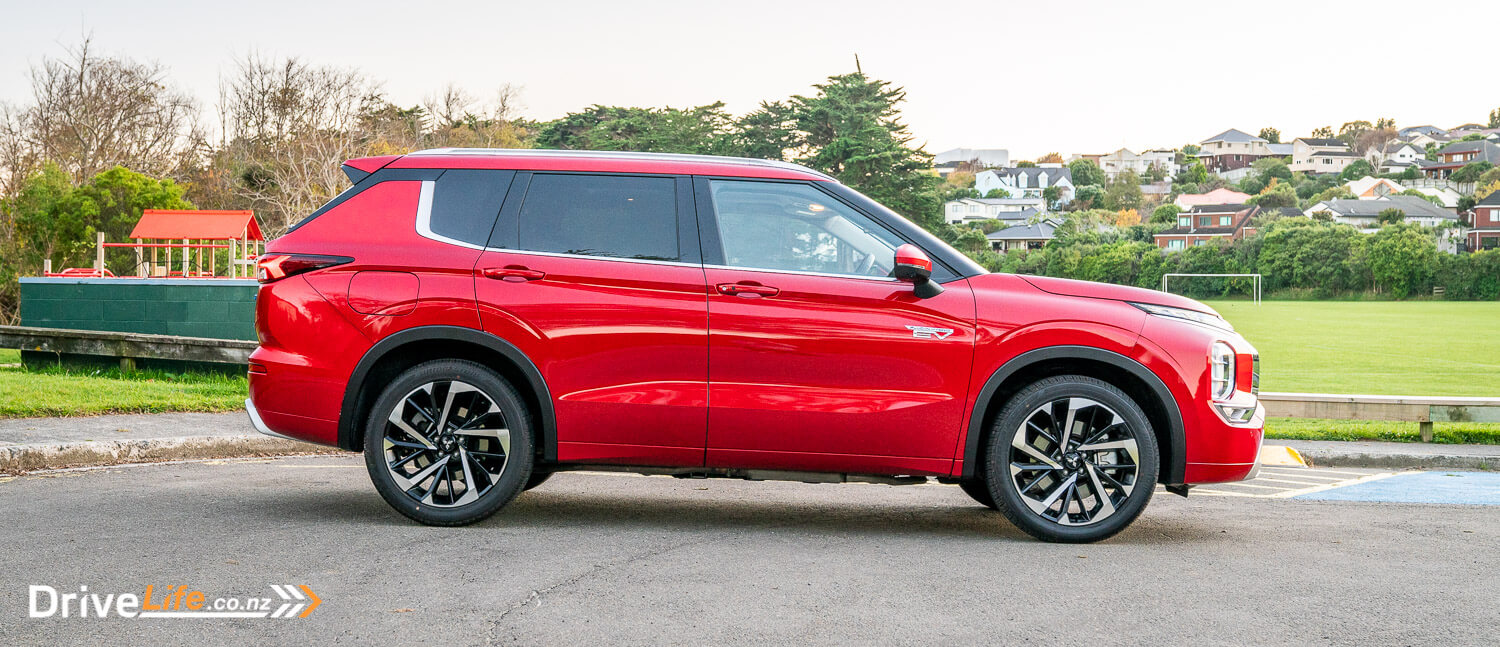
2022 Mitsubishi Outlander PHEV – Pricing
LS: $69,990
XLS: $75,990
VRX: $79,990
2022 Mitsubishi Outlander PHEV Standard Equipment Highlights
LS model:
- 18 Inch Alloy Wheels
- Black Cloth Seats
- 9 Inch Smartphone Link Display Audio
- 6 Speakers
- Keyless Operation System with Push Button Start
- Dual-Zone Climate Control
- 12.3 Inch Digital Display
- Reversing Camera
- Front & Rear Parking Sensors
- Full Advanced Driver-Assistance Systems Safety Suite
- LED Headlights
- LED Daytime Running Lights
- Electric park brake
- Electric lumbar adjust – driver’s seat
- Hill Descent Control
- Adaptive Cruise Control
- Traffic Sign Recognition
- Forward collision mitigation (with pedestrian/cyclist detection & junction assist)
- Lane departure warning
- Lane departure prevention
- Emergency lane assist
- Rear cross-traffic alert
- Rearview camera
- Multi-around view monitor with moving object detection
- Blind spot warning with lane change assist
- Active blind spot assist
- Rear automatic emergency braking
- Driver attention alert
- Trailer stability assist
- Parking sensors (front & rear)
- Rear seat alert
- Pedestrian approach warning system
- Stop lamp activation in high regenerative braking mode
- Apple CarPlay & Android Auto capability
XLS model adds:
- 7 Seats
- 20 Inch Machine-Finished Two-Tone Alloy Wheels
- Black Synthetic Leather Seats
- Driver & Passenger Front Row Heated Seats
- Smartphone Wireless Charging
- Tri-Zone Automatic Climate Control
- Power Drivers Seat Adjustments (8 Way)
- Leather Steering Wheel & Shift Knob
- Auto-Dimming Rear-View Mirror
- Front Rain-Sensing Wipers
VRX model adds to XLS specs:
- Black or Light Grey Leather Appointed Interior
- Power Remote Liftgate with Hands-Free Access
- Drivers & Front Passenger Power Adjustable Seat (8 Way) with Memory Function
- Passenger Power Lumbar Support
- Reverse Auto Tilt Mirrors with Memory Function
- USB X2 Rear Console (Type A&C) Charging Only
- Pull-Up Type Sunshade (2nd Row Seat)
- Multi Around View Monitor with Moving Object Detection
- Adaptive LED Headlights
- 10.8 Inch Head-Up Display
- Bose Premium Sound System with 9 Speakers
- Front Sequential Turn Indicators
- Auto Levelling Headlamps
- Panoramic Electric Sunroof
There are 9 no-cost colour options available:
- Cardona
- Sterling Silver
- Titanium
- Amethyst Black
- Deep Bronze
- Atlantic Blue
- Red Diamond
- White Diamond
- Black Diamond
The last two colours are only available on the VRX model.
If you buy the VRX model, you get to pick from black or light grey leather trim. Both the LS and XLS are black interiors only.
For a full list of specs and options available for the 2022 Mitsubishi Outlander VRX PHEV head on over to the Mitsubishi New Zealand website.
How Does The 2022 Mitsubishi Outlander VRX PHEV Compare To Its Competition?
Want a 7-seat PHEV? You have just two options currently. I’ve included one other option for comparison, but she’s slim pickings for PHEV SUVs under $100K. There’s a Hyundai Santa Fe PHEV coming soon – perhaps by the end of this year. The Toyota Highlander Hybrid misses out on our table since the top-spec $77,990 Highlander Limited ZR Hybrid isn’t a plugin hybrid.
All prices below exclude the refund or additional fee of the New Zealand Clean Car Programme.
| Make/ Model | Engine | Power/ Torque kW/Nm (combined) | Seats | Fuel L/100km | EV Battery Capacity kWH/range Km | Towing Capacity unbraked/ braked | Boot Space, Litres (3rd row down) | Price |
| Kia Sorento Plug-In Hybrid Premium | 1.6-litre, 4-cylinder turbocharged petrol/plug-in hybrid | 195/350 | 7 | 1.6 | 13.8/57 | 750/1,350 | 608 | $89,990 |
| Mitsubishi Outlander VRX PHEV | 2.4-litre, 4-cylinder petrol/plugin hybrid | 185/450 | 7 | 1.6 | 20/84 | 750/1,600 | 472 | $79,990 |
| Ford Escape ST-Line X PHEV | 2.5-litre 4-cylinder petrol plugin hybrid | 167/NA | 5 | 1.5 | 14.4/54 | NA/1,200 | 517 | $66,990 |

First Impressions Of The 2022 Mitsubishi Outlander VRX PHEV
When describing the front of the 2022 Outlander, I believe the term may be “bold”, or perhaps “daring”. There’s certainly no mistaking it on the road as it drives towards you. There sure is a lot happening up the front of the car, with lots of angles, design features and general busyness. Those slimline LED headlights help things along here, looking very smart.

The shape – mainly the front – is pretty galvanising too, as it seemed people either loved or hated it. I started not loving it, but I quite liked it by the end of our review. It grows on you. The whole front end is a huge departure from the previous gen, while the side and rear are unmistakably Outlander, carrying across the general design cues of the outgoing model.
Some of this might be down to the fantastic Red Diamond paint on our test car. It looks stunning in that colour at any angle.

What’s The Interior Like In The 2022 Mitsubishi Outlander VRX PHEV?
I know it sounds boring and maybe a bit pathetic, but the first thing I looked at on the inside of the new Outlander was the heated seat buttons. Right up to the outgoing model, the seat heater buttons looked like they belonged in the 1980s. In fact, I honestly think they were pulled from a huge parts bin of the same Mitsubishi seat heater rocker switches. I’m happy to say they’ve run out and now the Outlander has seat heat buttons that look modern.
Enough of my craziness. The rest of the cabin is pretty inviting and most passengers will be blown away by the apparent luxuriousness of the top-spec VRX Outlander. Pleated seats and doors, a nice mixture of fabrics, a huge panoramic sunroof to let in lots of natural light…there’s lots to love and little to not love.

Being the top-spec, the huge panoramic (split) sunroof lets in masses of natural light, and the front third of the sunroof is an electric tilt/slide unit, and there’s an electric blind to keep the light out if you want. Along with a beige headlining, the interior of the Outlander VRX is warm and open.
Front seat passengers get a USB-A and USB-C port, as well as a 12-volt socket for your dashcam and Qi wireless phone charging. The centre console has a nice, patterned alloy trim around the new funky (and easy to use) shifter, and to the right of that, there is some piano black to finish that side off.

There’s quite a mix of different materials and textures used in the cabin, but Mitsubishi has pulled it off and it’s all quite cohesive. Busy but pleasant, I would call it. The seats, console and doors have light contrasting stitching and it was great that from the driver’s seat, nearly all touch points are a soft finish of some sort. Mitsubishi has really moved ahead in this area.
In fact, the whole interior has shifted up massively in finish and look. I checked out the photos of the previous model I tested, and the new one is a huge change and a huge improvement. It was never bad, but the new interior is superb.

Getting into the driver’s side of the car can be a little awkward, as there’s a metal lump under the floor that can catch your foot on entry. After the first week, I managed to miss it every time but it does detract from what is an excellent interior. John, who is a lot taller than me, certainly struck it a lot more often.
Rear seat passengers still have loads of room, and a nice touch is the pull-up sunshades in the rear doors. Saves putting cloth nappies up to block the sun from your little one. Those in the second row also get access to a 1,500-watt power socket, and there’s another one in the cargo area. These are only fitted to the VRX model.

For the first time, the Outlander PHEV is a 7-seater. Sure, they’re occasional-use seats in the third row, but they are there to be used and could be quite handy when you have two siblings slugging it out. Nothing like a bit of separation to calm things down.
Having that third row has launched Mitsubishi into a very small niche, shared only with the Kia Sorento PHEV You can use the third row in a number of ways; when not in use, you get what is essentially a flat floor. When the third row is up, it comes out of the floor which gives you some extra depth over what you’d normally have, behind that third row. It’s all very usable, although the amount of space with the third row up isn’t actually listed.
With that third row down, the boot is still a good size at 472 litres, up slightly on the last model. There’s no spare tyre, but there is a 12-volt pump/repair kit in the boot.

What’s The 2022 Mitsubishi Outlander VRX PHEV Like To Drive?
This was going to be an interesting test, not least in comparison to the last gen Outlander Phev, but I just had handed back the new Skoda Superb iV PHEV – at exactly the same price. While the Superb is a large station wagon, the cost comparison can’t be ignored.
After the Superb I must admit that to start with, the Outlander made me feel a bit disconnected from the driving experience. The car feels larger than the outgoing model, and at times – initially, at least – it felt like a bit of a boat as I turned the wheel and then the front went in whatever direction I was asking it to. Again, it was an initial impression and by the end of my time with the car, I fell into a nice driving groove.
The plug-in hybrid side of things with the new Outlander is much the same but with a few improvements. You can of course just get in and drive, ignoring the hybrid aspects of the Outlander PHEV, and the car will do its thing and get you places just fine. If you want to make the most of using battery power to save money and emissions, then there are quite a few options to choose from.
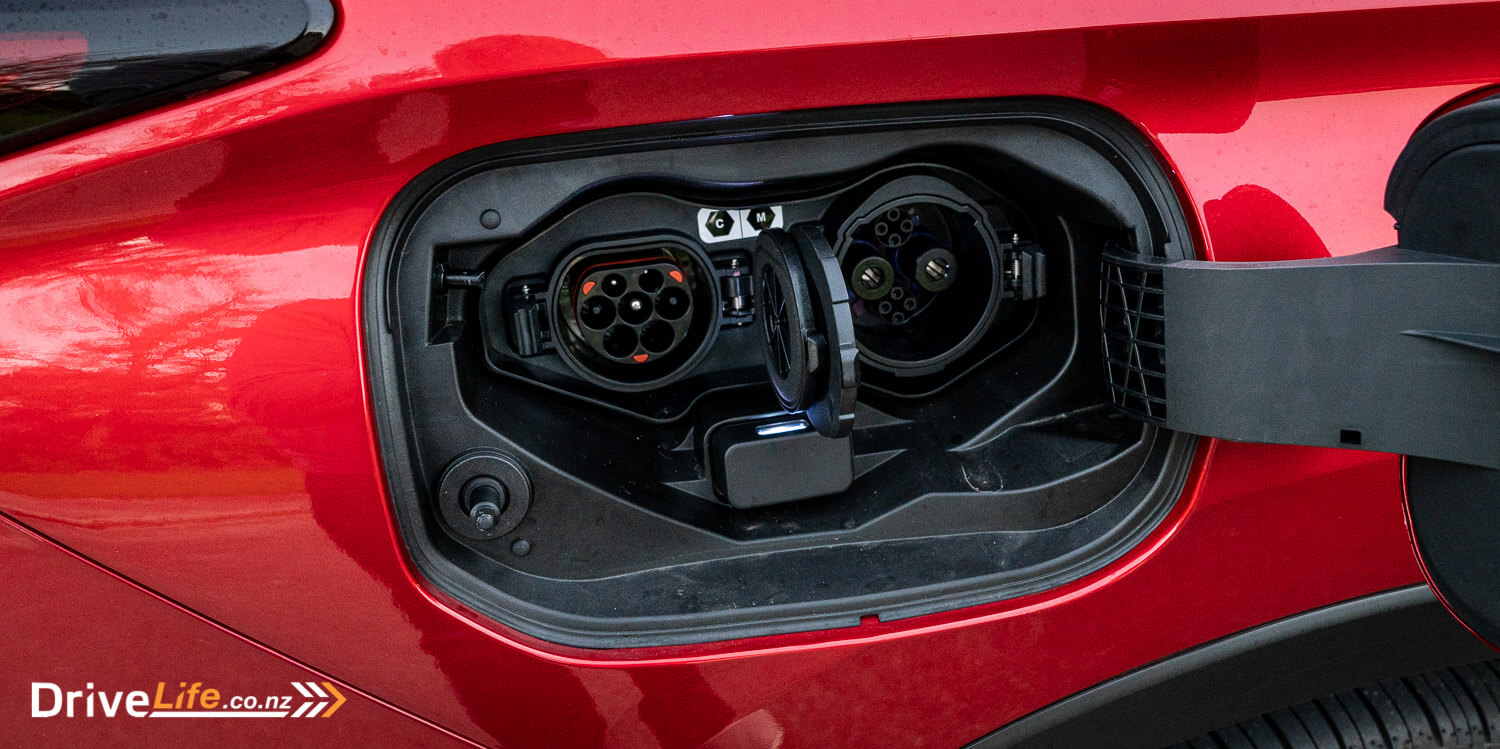
You still get the normal hybrid modes in this latest model;
- Normal – automatically optimises EV/Hybrid drive
- Save – priority is keeping the battery charge level
- Charge – recharges the battery as you drive
- EV Priority – Pure EV drive when the battery has enough charge to move the car
The car will always start off in EV Priority mode if there’s enough EV battery charge. If you want to, you can manage the battery charge on the mode, for example selecting Save or Charge if you are on the motorway to save battery charge. Again though, you can just get in and drive and let it be. If the battery gets low, the car will start the engine and then charge the battery while you drive, while still using the battery when it can. It’s all very seamless, and generally speaking, the engine is very quiet, so at times you won’t know it’s actually running.
In saying that, at times the engine can get pretty vocal. I found this the most going up the steepest part of Transmission Gully when the engine would be the loudest. Not quite screaming, but not that pleasant either. However, 95% of the time the petrol engine is a model of civility.
There are almost too many options around using brake regen in the new model Outlander PHEV. Paddles on the steering wheel allow you to increase/decrease brake regen, handy for controlling your speed down one of Wellington’s many hills and gaining a bit of battery charge to boot. Weirdly, if you select anything stronger than regen 3, the engine will often start. Not sure why this happens and it doesn’t help your fuel economy. Our test car was missing its owner’s manual so I couldn’t check out why this was occurring.

A new feature to this year’s model is a ‘Pedal’ button on the centre console. This almost allows one-pedal driving and applies strong brake regen as soon as you start lifting your foot from the accelerator. It does take some determination to drive like this, and I expect some people wouldn’t bother. But it does allow for less pedal work and will generate more charge into your batteries due to the extra brake regeneration applied.
Then there’s the new, futuristic shifter. It looks good and feels great. Moving the lever into D will get you moving forward, and pulling the lever again will set the car into B mode. This is a common mode used by many manufacturers to apply brake regen. Of course, pulling on either of the paddles will move the car into B mode anyway. Holding the right-hand paddle in for three seconds will revert the car to D mode, which is equivalent in brake regen to level 2 – or you could pull on the transmission shifter again. As I said, lots of options are available.
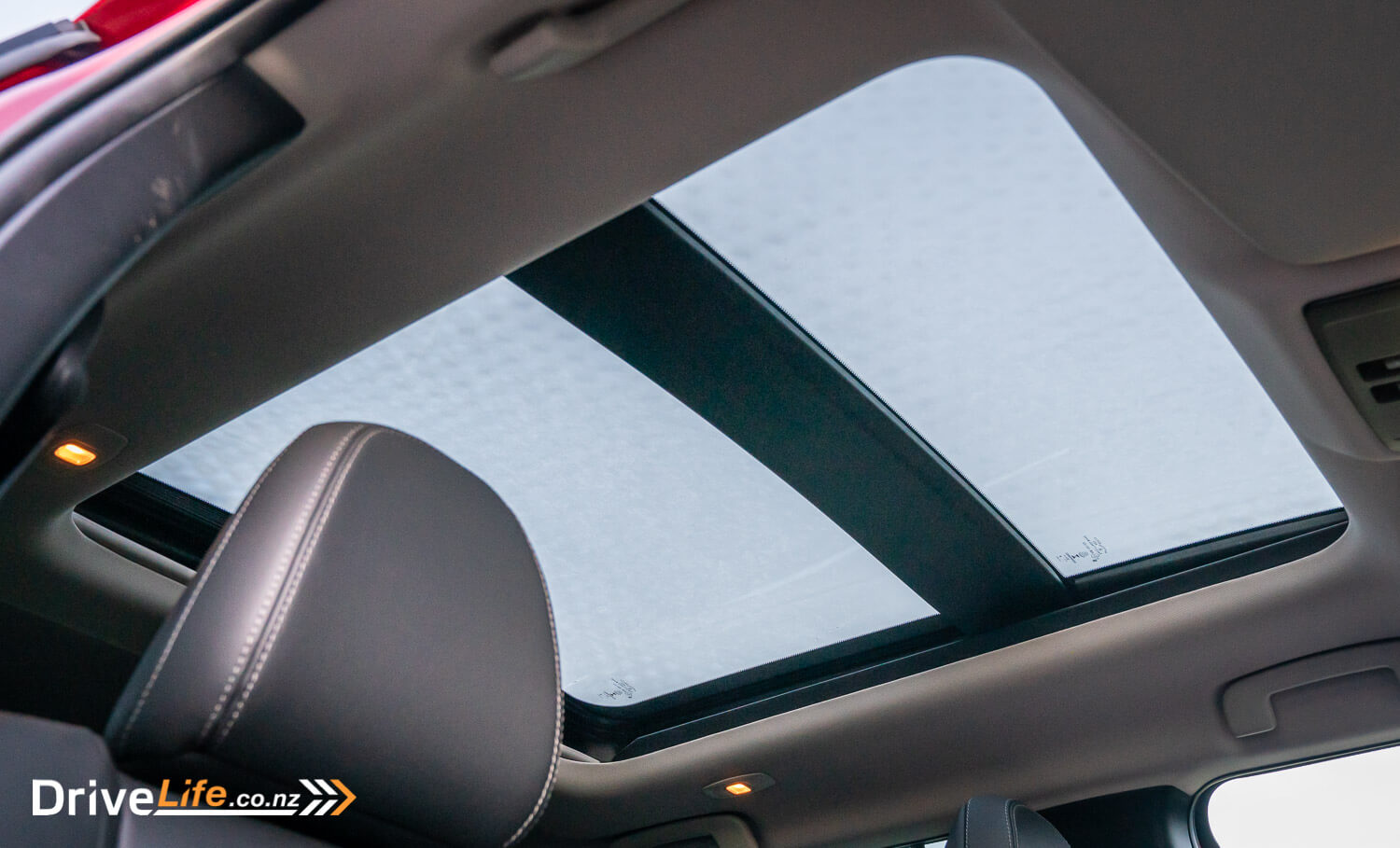
But wait, there’s more. While you get to pick from EV Modes like Save and EV Priority, you can also use the rotary selector on the centre console to pick from Drive Modes of Power, Eco, Tarmac, Normal, Gravel, Snow, and Mud. Since there’s an electric motor at each end of the car, the Outlander offers all-wheel drive using a tri-motor system that Mitsubishi calls Super All Wheel Control (SAWC). This should give some assurance to those skiers out there, or those tending to their lifestyle blocks on long weekends.
The 2022 Outlander PHEV has three modes of PHEV operation: Pure EV, Series Hybrid where the petrol engine only charges the battery, and Parallel Hybrid mode where the engine assists with acceleration. Unless you have the info screen up you would never know which mode it’s in. Again, just get in and drive it and let the car work it out.

The new “Power” Drive Mode could be considered Sport mode if you like, as – according to Mitsubishi – it “provides amazing acceleration”. It does make the car pick up more quickly than the other modes, but honestly, quick performance is not what this car is about and after the first few minutes, I switched the car back to EV mode. Eco mode didn’t seem to make any actual difference to the driving of the car as far as dulled performance goes, so I generally left it in Normal and we were good. You can of course select Eco mode – or any of the others – but as soon as you start the car again it reverts back to Normal.
A nice touch to the car is the EV Usage screen on the centre display. For the first time that I remember, here is a graph that shows the total kiloWatts being used or charging. It may be a bit geeky but it does mean that, for example, you can see exactly how much charge is going into the battery downhill. It’s especially handy when going down Ngaruanga Gorge, and more alarming going up the gorge.

Charging the 2022 Outlander VRX PHEV is a doddle; get home, plug it in. People often ask how long it takes to charge such a car, but it’s 30 seconds to open the charge flap and plug it in, and then you walk away. The car will take overnight to charge on a standard 230-volt, 8-amp power socket. I expect that 90% of the Outlander PHEVs past and present are charged this way. It’s cheap, and it’s easy. If you are away from home and want to plug in and charge up, the car has a ‘CHAdeMO’ DC charging port. This means the car is limited to 50kW charging power, and that means that from flat, it will take around 38 minutes to charge to 80% at a public fast charger. Still, why bother? Just drive the car and let the engine charge it up as you drive.
Other bonus items for me at least include the fact that the car remembers you had the seat heater on when you got out, and simply puts it back on again when you return to the car. A simple feature, but one I appreciate. In fact, both front seats are heated, have electric adjustment, and both have memory buttons on the door. The Outlander VRX PHEV is one well-kitted-out car.
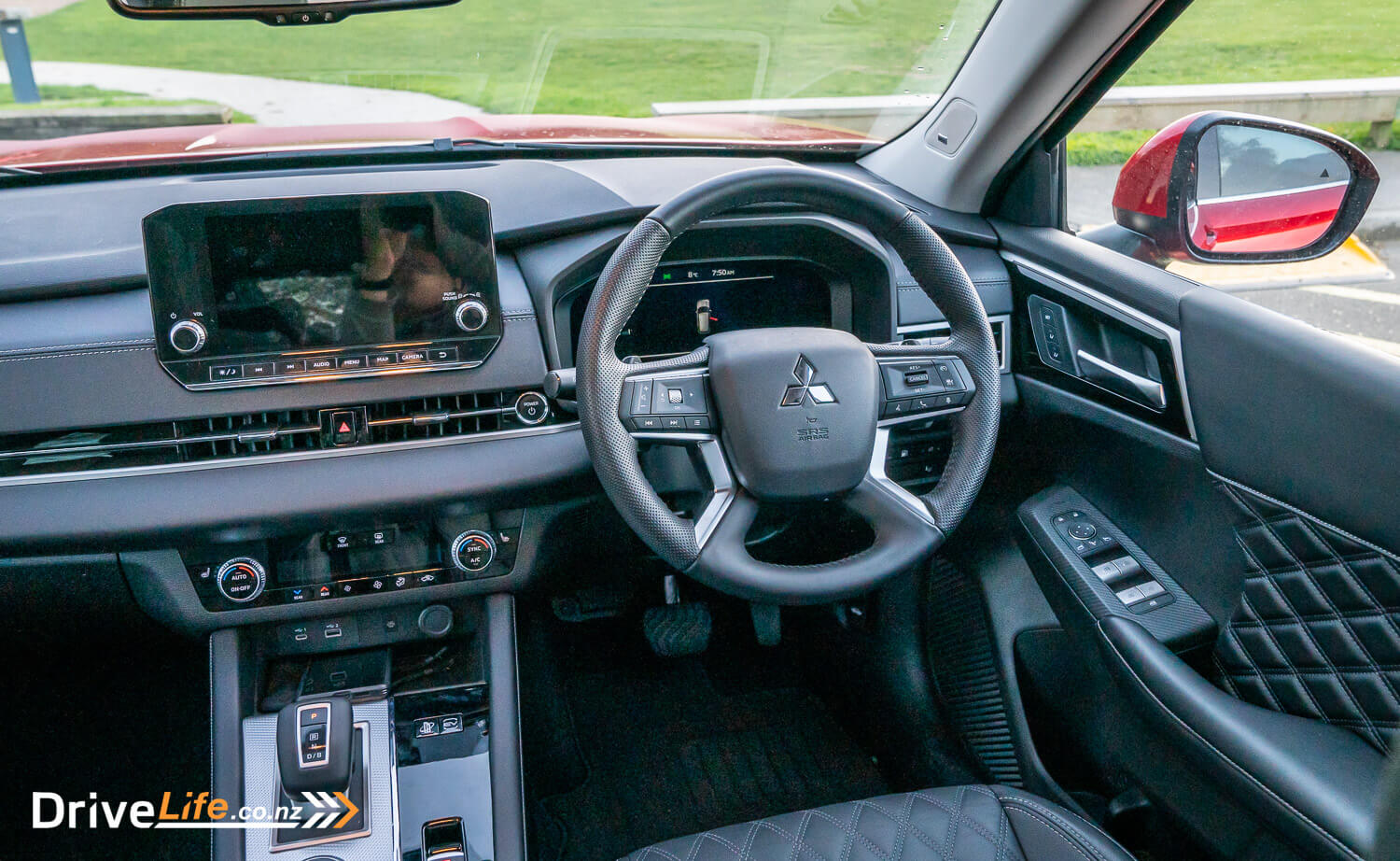
That impressive kit includes a heads-up display (HUD), one that shows you the standard items like your current speed, the current speed limit, SatNav directions, and audio info. In saying that, the Traffic Sign Recognition that feeds the HUD (and the current speed limit is shown on the centre display if you have the map on) was a bit dodgy, often getting the speed limit wrong. We’ve had a string of cars lately with this issue, so here’s hoping it’s sorted out soon. If you get pulled over, saying that the traffic sign recognition is not the best isn’t going to get you off a ticket.
I found SatNav in the Outlander mostly good, with lots of instructions on the HUD and centre display. Searching was a bit hit and miss, with one I did for 98 High Street bringing up the first page of results in Australia, the closest one being 3,000KM of sometimes very wet driving. Once I added “Lower Hutt” to the search it was fine, but I can never understand why manufacturers simply don’t block results from countries other than where the car is located. Weird.

The infotainment system has real volume and track/station knobs, things that we are seeing less of. Other little treats include electric windows that are all automatic up/down, excellent adaptive LED headlights, and at the end of each journey, you are shown a drive report with the amount of fuel and kWh of battery charge you have used. If you’ve got a new (low) record, you can tell the car to update it with the new record. Geeky, but a little cool too.
The new Outlander has all-new steering wheel controls, and they work just fine. I think a lot of people feared they might move to (horrible) haptic controls on the wheel, but what they have done is just fine. I’m not sure the old controls were bad at all, but the new ones soon become very familiar, with little reason to look down at what you are pushing.
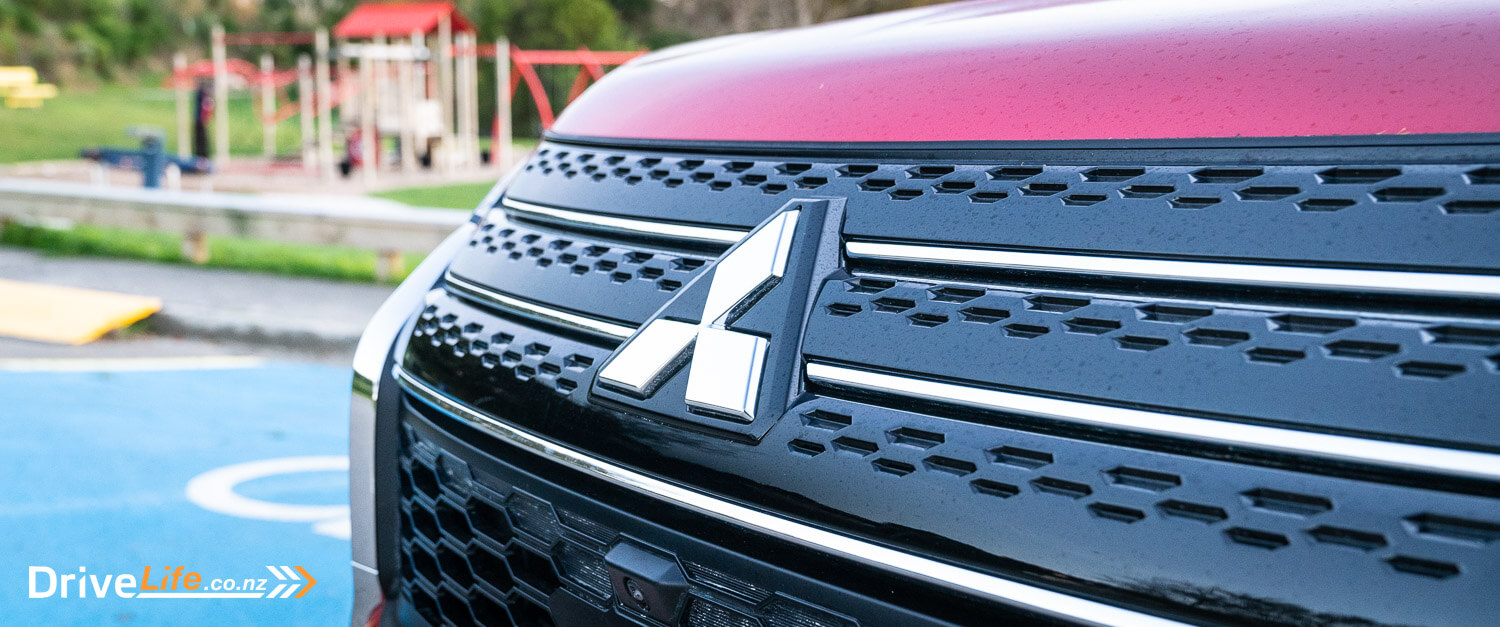
Not-so-good things worth mentioning? There are some, but on the whole, this car is excellent. Things that could be better include visibility out of the car; the three-quarter view is limited, but this is often the case with an SUV. There is blind-spot monitoring to keep you safe, at least. The car has an electric park brake – which is fine – but the auto-hold function of the electric park brake doesn’t stay on when you get out of the car, and back in again. The engine will often start as soon as you put the front windscreen demister on, and will stay on a lot more if you are running the aircon. The new user interface for the infotainment system has better quality graphics than before, but it can lag some between screens. It’s not as bad as some we’ve seen, but there is certainly a delay. While screen resolution is better than we saw in the old model, Mitsubishi is still getting left behind here a little, as other brands have sharp, crisp resolution on their centre screens.

I think the biggest thing that I didn’t like was the adaptive cruise control. It works just fine and will bring you to a stop – but only for a few seconds. Then there’s a beep, and the brakes let go and yes the car will start moving forward. If you have the audio up too loud, you aren’t going to hear the beep. I’m not sure it would take much for the car to stay stopped, so unsure why Mitsubishi have the adaptive cruise control working in this way.
Our 4 weeks with this car included a trip to Hawera, to work on our project car. This meant a 4-hour drive each way, the Outlander PHEV loaded up with all sorts of car bits and pieces. The whole trip was a breeze, and proved again that this car is comfy, smooth, quiet, and an easy drive. Power wasn’t really an issue on that trip, and I did find myself leaving it in Eco mode all the time, and then slipping it into Power mode when needing to overtake slower traffic. It can really get up and go in Power mode, even with some weight on board.
On leaving Wellington, fuel economy overall was sitting on 3.2L/100km. After my 800Km drive to Hawera and back, it ended up at 4.5L/100Km. I purposely did not charge the Outlander up while on that trip, to see how it fared. Getting 4.5L/100Km out of such a big, heavy wagon with a 2.4-litre engine is still very impressive. Interestingly, on my last test with the outgoing Outlander PHEV I managed 2.8L/100Km, but that didn’t include any long trips away.

JOHN’S POINT OF VIEW
Following on from the Outlander being the 2021 DriveLife Car of the Year, the PHEV had to impress. The styling had not really changed, and between the ‘normal Outlander and the PHEV version, there are just a few PHEV badges dotted around to indicate the difference, so far so good.
The drive was pretty much the same as the petrol model, quieter and smooth thanks to the electric motors. I loved the new dash display which gave you some additional options over the normal dials, with rotating cylinders to show the speed and power use. I do recall the previous model being a bit more predictable when it was in full EV or petrol mode. I was never sure if the aircon was using too much power or if the vehicle just felt it was not right to use the full EV mode. More often than not it got it right, but many times it did its own thing and used the petrol engine when there was plenty of power in the battery. Over the course of my time in the new PHEV, I covered a lot of km, but it didn’t seem to really have much effect on the range based on how I drove and recharged the battery each night.
The only downside I see about the new PHEV’s battery size; it takes a lot longer to charge it at home on the standard charger. If speed is an issue for people in the future, thin may need to consider a 3-phase line or a 32-amp charger at their house for faster charging.
I am a big fan of the new Outlander, for many reasons, styling, value for money and a complete package. The icing on the cake for me is the PHEV, making it super economical to run on top of everything else. It’s really hard to beat the Outlander VRX PHEV when it comes to great all-round family vehicles.
ROB’S POINT OF VIEW
I drove the base spec of the previous Outlander as well as the top-spec PHEV and was impressed by its comfort, quietness and levels of refinement. It certainly left a good impression and is a car we will be looking closely at when it comes time to retire our family car.
I was keen to see what this new model had done to move things forward, especially as prices have gone up over the outgoing models. First impressions were good, interior quality is excellent and the quilted leather on the doors and seats really lifts things. Everyone who saw it was impressed. It’s comfortable, has lots of space, and just about everything you need. Plugging it in every other night was enough to get me to and from work on pure electric.

I took the Outlander over Remutaka Hill for a weekend away in some of the stormiest weather we’ve had in months. The car handled the wet, twisty roads well, feeling safe and composed at all times. There was an occasional bounciness to the ride on more undulating stretches of highway, but nothing unpleasant. It was quiet, sipped the fuel, and I gained back 11km of range on the way down the hill, which is always very satisfying.
The new Outlander PHEV continues to be an excellent family car, with the ability to be emissions-free for your local journeys, but with a more-efficient petrol/electric system for longer trips. It’s the best of both worlds with current technology.

2022 Mitsubishi Outlander VRX PHEV – Specifications
| Vehicle Type | 5-Door, Plug-in Hybrid Medium-Large SUV |
| Starting Price | $73,990 |
| Price as Tested | $73,990 |
| Engine | 2.4-litre, 4-cylinder petrol |
| Power, Torque kW/Nm | Petrol engine: 98/195 Front Electric Motor: 85/255 Rear Electric Motor: 100/195 |
| Transmission | CVT |
| Spare Wheel | Pump only |
| Kerb Weight, Kg | 2,110 |
| Length x Width x Height mm | 4710x1862x1740 |
| Boot Space / Cargo Capacity, Litres (seats up/seats down) | 472/1,392 |
| Fuel tank capacity, Litres; fuel octane | 56, 91 |
| Fuel Economy, L/100km | Advertised Spec – Combined – 1.6 Real-World Test – Combined – 4.5 Low Usage: 0-6 / Medium Usage 6-12 / High Usage 12+ |
| EV Battery voltage/Capacity, volts/kWh | 350/20 |
| Towing Capacity Kg, unbraked/braked | 750/1,600 |
| Turning circle metres | 11.2 Small: 6-10m / Medium 10-12m / Large 12m+ |
| Warranty | 10 Year/160,000Km Powertrain Warranty 5 Year/130,000Km New Vehicle Warranty 5 Years Premium Roadside Assistance 8 Year/160,000Km Battery Warranty |
| Safety information | ANCAP Rating – 5 stars – Link Rightcar.govt.nz – 5 Stars – PAY52 |
Have you enjoyed this review? Be sure to join our monthly email newsletter list so you don’t miss a single car review!









Great review. Does the VRX model have the remote start function?
Hi Julius
Thanks for the kind comment. Interesting question – I don’t recall seeing this function on the remote, and I think if it was there, I would have taken note. I’ve just gone through all the press material we have for this model, and there’s no mention of it.
Cheers
Fred
Pretty comprehensive test, thanks. Did you check the actual electric-only range after a full, at-home recharge? One overseas test found it was no greater than for the previous model with its smaller, 13 KWh battery.
Hi Brian
I got an indicated 83Km at best after charging overnight at home, to 100% charge. The actual driving range was about 70-75Km for me, so definitely better than the last model.
Thanks, Fred.
Was this only city driving or mixed city and highway?
HI Anthony
All of our review’s “real-world” fuel economy figures are a mix of driving conditions, unless otherwise stated.
Cheers
Fred
Hi Fred.
I note that you did the Kia Sorento PHEV review last. As the obvious competition do you have a preference?
Cheers
HI Mark. I was afraid someone would ask this. It’s a tough call to make. The Sorento feels better built and more…well, just more. But it’s $10K extra. Money no object it’s the Kia, but for its price and equipment levels, the Outlander can’t be beat.
Cheers
Fred